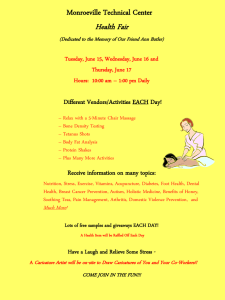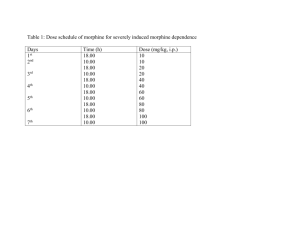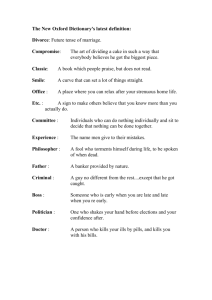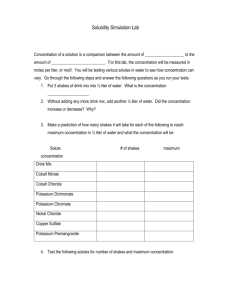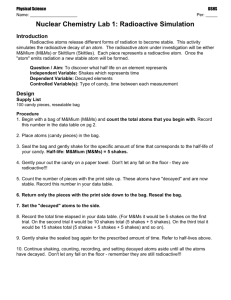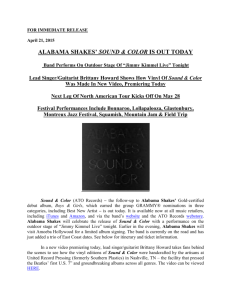Glo Germ Classroom Kit Lessons
advertisement
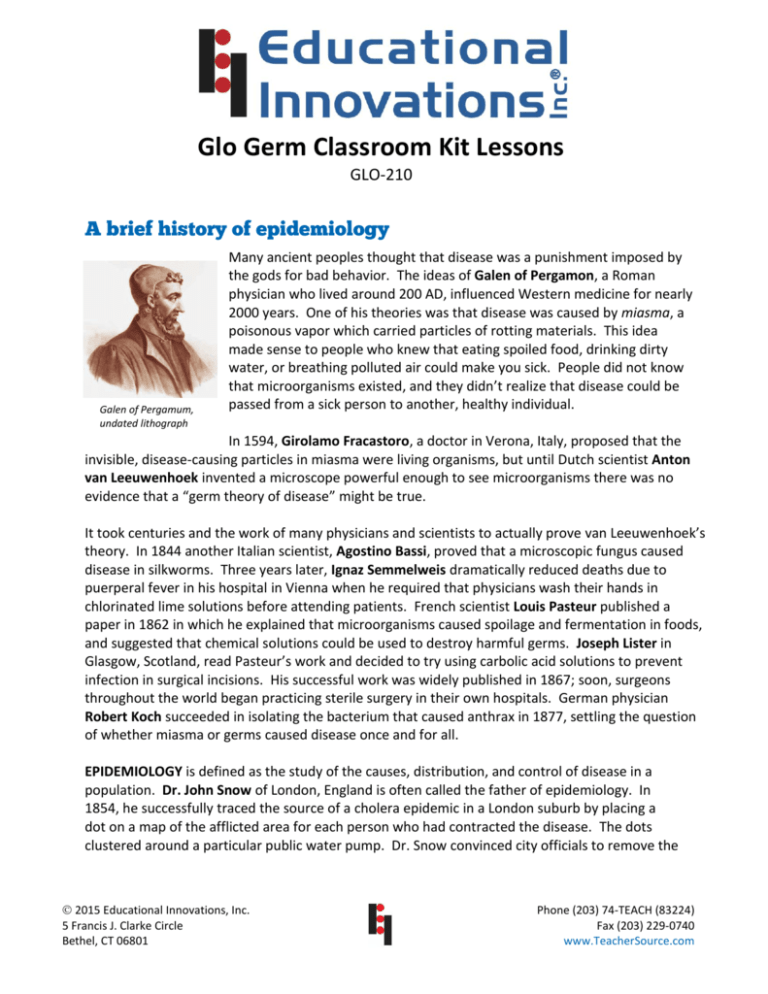
Glo Germ Classroom Kit Lessons GLO-210 A brief history of epidemiology Galen of Pergamum, undated lithograph Many ancient peoples thought that disease was a punishment imposed by the gods for bad behavior. The ideas of Galen of Pergamon, a Roman physician who lived around 200 AD, influenced Western medicine for nearly 2000 years. One of his theories was that disease was caused by miasma, a poisonous vapor which carried particles of rotting materials. This idea made sense to people who knew that eating spoiled food, drinking dirty water, or breathing polluted air could make you sick. People did not know that microorganisms existed, and they didn’t realize that disease could be passed from a sick person to another, healthy individual. In 1594, Girolamo Fracastoro, a doctor in Verona, Italy, proposed that the invisible, disease-causing particles in miasma were living organisms, but until Dutch scientist Anton van Leeuwenhoek invented a microscope powerful enough to see microorganisms there was no evidence that a “germ theory of disease” might be true. It took centuries and the work of many physicians and scientists to actually prove van Leeuwenhoek’s theory. In 1844 another Italian scientist, Agostino Bassi, proved that a microscopic fungus caused disease in silkworms. Three years later, Ignaz Semmelweis dramatically reduced deaths due to puerperal fever in his hospital in Vienna when he required that physicians wash their hands in chlorinated lime solutions before attending patients. French scientist Louis Pasteur published a paper in 1862 in which he explained that microorganisms caused spoilage and fermentation in foods, and suggested that chemical solutions could be used to destroy harmful germs. Joseph Lister in Glasgow, Scotland, read Pasteur’s work and decided to try using carbolic acid solutions to prevent infection in surgical incisions. His successful work was widely published in 1867; soon, surgeons throughout the world began practicing sterile surgery in their own hospitals. German physician Robert Koch succeeded in isolating the bacterium that caused anthrax in 1877, settling the question of whether miasma or germs caused disease once and for all. EPIDEMIOLOGY is defined as the study of the causes, distribution, and control of disease in a population. Dr. John Snow of London, England is often called the father of epidemiology. In 1854, he successfully traced the source of a cholera epidemic in a London suburb by placing a dot on a map of the afflicted area for each person who had contracted the disease. The dots clustered around a particular public water pump. Dr. Snow convinced city officials to remove the 2015 Educational Innovations, Inc. 5 Francis J. Clarke Circle Bethel, CT 06801 Phone (203) 74-TEACH (83224) Fax (203) 229-0740 www.TeacherSource.com handle from the pump so it couldn’t be used; the outbreak ended. A check of the water company revealed that the water source for that pump was a polluted section of the Thames River. The Centers for Disease Control and Prevention (CDC), part of the Department of Health and Human Services, coordinates epidemiology in the United States. The CDC’s mission “is to collaborate to create the expertise, information, and tools that people and communities need to protect their health—through health promotion, prevention of disease, injury and disability, and preparedness for new health threats.” (www.cdc.gov/about/organization/cio.htm) An outbreak of a certain disease is considered an epidemic if the number of cases is significantly higher than what you’d expect for a particular group of people at a particular time of year. Thus, a few cases of a very rare disease might be considered an epidemic while hundreds of cases of the common cold in winter would not. If the outbreak extends to other countries or continents it is called a pandemic. A disease is endemic if it is typically found in a population without having to be brought in from the outside, for example chickenpox in the United States. National health organizations like the CDC partner with international organizations like the World Health Organization (WHO) to prepare for and control epidemics and pandemics. Bacteria are single-celled organisms too small to be seen by the naked eye. Bacteria are all around us; by some estimates the weight of all the bacteria on Earth is greater than that of the weight of all the plants and animals on Earth combined! (http://en.wikipedia.org/wiki/Bacteria) While most bacteria are harmless, and some, such as those that inhabit our intestines, are required to stay healthy, others cause disease. We often refer to disease-causing bacteria, viruses and fungal spores as “germs.” Foodborne illnesses, commonly called food poisoning, occurs when you eat or drink food that contains disease-causing bacteria, viruses, or fungi, or the toxins (poisonous substances) made by them. Food can be contaminated through improper processing, improper storage and transport of foods, and improper preparation and handling. One of the most common foodborne illnesses is salmonella entercolitis, an infection of the lining of the small intestine, caused by Salmonella bacteria. A note about lighting: Before presenting any of these lessons, it’s important to test the darkness of your room to make sure that your students will be able to see the Glo Germ lotion or powder fluoresce under the ultraviolet light. Ultraviolet light is electromagnetic radiation If you cannot get your room dark with wavelengths of 10 nanometers to 400 enough, you may have to prepare a nanometers, shorter than visible light but longer than x-rays. Some substances, after viewing chamber using a cardboard absorbing ultraviolet light radiation, emit box or a blanket draped over a chair. energy as visible light in a process called fluorescence. Examples include flowers pollinated by insects, which can see ultraviolet light, many minerals, and numerous chemicals which are colorless or white under visible light. 2015 Educational Innovations, Inc. 2 www.TeacherSource.com Lesson 1 Proper Hand Washing Can Help Stop the Spread of Germs and Diseases Introduction: People used to believe that disease was caused by miasma, a poisonous vapor which carried particles of rotting materials that caused illness. People knew that eating spoiled food, drinking dirty water, or breathing polluted air could make you sick, so this idea made sense to people who did not know that microorganisms—tiny living creatures too small to be seen by the naked eye— even existed. People did not know that diseases could be passed from one person to another. Even doctors would go from one sick person to another without washing their hands. In 1847 Ignaz Semmelweis dramatically reduced the deaths due to puerperal fever in his hospital in Vienna, Austria when he required that physicians wash their hands in chlorinated lime solutions before touching patients. Hand washing is still the first line of defense in preventing the spread of disease, but if your hands aren’t washed properly you can still pass germs to others. Materials: Glo Germ Classroom Kit #GLO-210 (contains Glo Germ lotion, Glo Germ powder, and a UV light) paper towels soap and water 8.5” x 11” piece of paper and a pencil for each student colored pencils or crayons Directions: Provide each student with a blank piece of paper and a pencil. Ask the students to trace around one of their hands with the pencil and then set both aside. Place a nickel-sized blob of Glo Germ lotion onto the palm of one hand of each student. The students should rub the lotion onto both hands, being sure to cover the areas between their fingers and around their fingernails. Any excess lotion should be wiped off with a paper towel. Explain that the lotion contains tiny particles that fluoresce, or glow, under ultraviolet light. Tell students: Today we’re pretending that these tiny particles in the lotion are bacteria or “germs.” Bacteria are single-celled organisms too small to be seen by the naked eye. Bacteria are all around us; by some estimates the weight of all the bacteria on Earth is greater than that of the weight of all the plants and animals on Earth combined! Most bacteria are harmless and we need some types of bacteria, such as those that inhabit our intestines, to stay healthy. But other bacteria cause disease. We often refer to disease-causing bacteria, viruses and fungal spores as “germs.” Proper hand washing removes these germs from our skin so we cannot pass them along to other people, or transfer them to our food, eating utensils, toothbrushes etc. 2015 Educational Innovations, Inc. 3 www.TeacherSource.com Allow the students to view their “germ”-covered hands under the ultraviolet lamp. They should notice many glowing areas on their skin, nails and around their cuticles. Instruct students to wash their hands using soap and water the way they usually do, then recheck their hands under the UV light. The effort it takes to completely wash the lotion off one’s hands is similar to the effort it takes to remove most bacteria. Did the students remove all of the “germs”? Have the students use colored pencils or crayons to mark on the paper tracings of their hands where the “germs” remained. Compare pictures; did most students leave “germs” behind in the same locations? What are those problem areas? Did chapped or cracked areas retain more “germs” than other areas? Tell students: Our skin keeps the microorganisms from getting into our bodies. Germs get into our bodies through cracks and cuts in our skin, so it is important to keep it intact and healthy. If your school already has a hand washing protocol in place, review this with your students. If not, review the following guidelines from the CDC (http://www.cdc.gov/Features/HandWashing): Hand Washing Guidelines Wet your hands with clean running water (warm or cold) and apply soap. Rub your hands together to make a lather and scrub them well; be sure to scrub the backs of your hands, between your fingers, and under your nails. Continue rubbing your hands for at least 20 seconds. Need a timer? Hum the “Happy Birthday” song from beginning to end twice. Rinse your hands well under running water. Dry your hands using a clean towel or air dry. Give the students the opportunity to try to wash the rest of the lotion off of their hands. Was anyone able to completely remove the “germs” from their skin? What have the children learned about proper hand washing? Your students may ask why we can’t simply use hand sanitizers to stay healthy. Our hands are ecosystems, home to millions of microscopic organisms. When we wash our hands, we remove microorganisms from our skin. Hand sanitizer does not remove the microorganisms; it simply changes the environment on our hands, killing some microorganisms and making it harder for others to survive. However, hand sanitizers do not kill all the microorganisms living in the ecosystems on our hands. Some individual cells are naturally resistant to the chemicals in hand sanitizer and aren’t killed. Those resistant cells remaining on our hands will reproduce, resulting in even more microorganisms that are resistant to hand sanitizer. It’s hard to become resistant to being washed away, so it is better to wash your hands with soap and water whenever possible. 2015 Educational Innovations, Inc. 4 www.TeacherSource.com Lesson 2 Cross-Contamination in the Kitchen Introduction: Foodborne illnesses, commonly called food poisoning, occur when you eat or drink food that contains disease-causing bacteria, viruses, or fungi, or toxins (poisonous substances) made by them. Preparing food with unwashed hands, using contaminated utensils when preparing food, or eating raw fruits and vegetables without washing them first are some of the ways harmful germs get into food. Sometimes food poisoning impacts a large number of individuals at the same time—such as people who ate potato salad that stayed out in the sun too long at a picnic, or ordered the same dish at a particular restaurant, or consumed food that had been tainted at the factory where it was produced. Ask if any of the students have experienced food poisoning. Do they know where they contracted it? Today’s activity will show students how to prevent contaminating food prepared at home. Materials: Glo Germ Classroom Kit #GLO-210 (contains Glo Germ lotion, Glo Germ powder, and a UV light) assorted small cutting boards (used, new, plastic, glass, wood etc.) or pieces of paper non-porous salad or dinner plates (plastic, ceramic etc.) plastic knives with serrated edges dishwashing liquid sponges or other scrubbers for washing dishes lettuce leaves (iceberg or romaine are good choices) one large or two small cucumbers plastic food storage bags with zipper closures paper towels Before class: Slice the cucumber into ⅛” thick slices, enough to provide two slices per team of students plus one. Cut the lettuce leaves into pieces roughly the size of a playing card, enough for one slice for each team of students plus one. Place the cucumber slices into one plastic bag, seal, and set aside. Place the lettuce leaf slices into another. Shake a little Glo Germ powder onto the lettuce leaves, seal the bag, and shake it vigorously to coat all of the pieces. Remove and check one leaf under the UV lamp to make sure it has been sufficiently “contaminated.” If not, return it to the bag, add more powder and repeat the process. Thoroughly wash your hands to remove any traces of the powder, and be sure not to contaminate any of the cutting boards, knives etc. with the powder prior to class. Confirm that the cucumber slices have not been contaminated. 2015 Educational Innovations, Inc. 5 www.TeacherSource.com Directions: Supply each team of students with a knife, cutting board or piece of paper, and a dinner plate. Give one member of each team a lettuce leaf piece from the bag. Instruct each team to slice its leaf into very tiny pieces, about ¼” square, on the cutting board or piece of paper, then scrape the lettuce pieces onto the salad or dinner plate. (While the students are cutting, consider washing your own hands in case any powder got onto them from handling the lettuce bag.) Next go from team to team, handing them one cucumber slice. Instruct the teams to cut the cucumber into tiny pieces as they did with the lettuce, leaving those pieces on the cutting board or piece of paper. Now instruct the students to discard the lettuce pieces into the garbage bag, returning with the plate to their stations. Finally, go from team to team, placing a cucumber slice directly onto each now empty salad or dinner plate. Darken the room so that the fluorescence from the contaminated items is more easily seen. Place the lettuce leaf remaining in the plastic bag under the UV light. Tell students: These lettuce leaves were dusted with a harmless powder that glows under ultraviolet light. The powder represents bacteria like salmonella or E. coli. You can imagine the bacteria might have got onto the lettuce while it was transported from the fields where it was grown. Place the remaining cucumber slice under the UV light to show that it was not contaminated by “bacteria.” Ask each team to turn over the intact cucumber slice on their dinner plate. Travel from team to team, shining the UV light onto the cutting boards or papers, knives, cucumber pieces and plates. Also shine the light onto the students’ hands. If you used actual cutting boards, ask each team to wash and dry its board. Recheck the cleaned boards with the UV light. Clean-up: Dispose of the cucumber pieces and any papers used as cutting boards in the plastic garbage bag. Instruct students to wash their hands with soap and water. Discussion: Allow time for teams to discuss what they observed and consider how this activity relates to safe food preparation practices. Be sure to cover these points: 1. Should you always wash raw fruits or vegetables before eating them? 2. Why do food service workers wear gloves when handling food? 3. Should you place unwashed fruits and vegetables or uncooked food (like raw hamburger) on the same dishes you’ll place food ready to eat onto later on? 4. What kinds of cutting boards are easiest to keep clean? (used, new, wooden, plastic, glass?) 5. Should you use the same cutting boards and knives for foods that will be eaten raw that you use for preparing raw meats or unwashed vegetables? 6. Should you use the same cutting boards and knives for meat before and after it is cooked? 2015 Educational Innovations, Inc. 6 www.TeacherSource.com Lesson 3 How Germs Spread (Suitable for younger students) Introduction: People used to think that angry gods caused disease, or that a poisonous vapor that came from rotting food or bad air caused illness. It took thousands of years for people to understand that it was the microorganisms—bacteria, viruses, one-celled animals and fungi too small to be seen by the naked eye—in spoiled food, dirty water, or polluted air that made us sick, not the bad food or water itself. People did not know that diseases could be passed from one person to another. It has been less than 150 years since the first disease-causing bacteria was identified! We now know that infectious disease can be spread directly from one person to another. Materials: Glo Germ Classroom Kit #GLO-210 (contains Glo Germ lotion, Glo Germ powder, and a UV light) Directions: Out of sight of the students, sprinkle the palm of your right hand with Glo Germ powder. Ask for five volunteers. Greet the volunteers as you normally would at the beginning of the school day, shaking hands with each student. Have the volunteer students return to their seats. Then instruct all the students to stand up and greet any three classmates, shaking hands each time. Once this has been accomplished, ask the students to return to their places. Darken the room and shine the UV light onto your right hand. Explain that you’ve sprinkled a powder onto your hand that glows under ultraviolet light. Tell students: This harmless powder is made up of tiny particles about the same size as a bacterium. Today we’ll pretend that this powder is a “germ” which can make someone very sick. Imagine that I came to school today with a cold, and I sneezed into my hand. Now I have those “germs” on my hand. Shine the UV light onto students’ hands. Explain that anyone whose hands glow has essentially caught the same “disease” you have. Discussion: Are they surprised at the number of students who got “infected” with the Glo Germ powder? Ask the students how many students they think would have gotten “sick” by the end of the school day. As a class, develop a list of ways they can prevent spreading actual germs and diseases to their classmates. At the end of the discussion, remind students to thoroughly wash their hands with soap and water. 2015 Educational Innovations, Inc. 7 www.TeacherSource.com Lesson 4 Epidemic (Suitable for older students) This lesson is modeled after the classic college level biology experiment in which a relatively harmless bacterium is passed from student to student and the results determined by culturing that bacteria between lab sessions. Using live bacteria is generally not appropriate for middle or high school students. Glo Germ lotion allows you to perform a reasonable version of this enlightening activity. This lesson will probably take two class periods depending on the scenario chosen and the size of your class. You may want to perform the experiment on the first day, especially if you are doing more than one round of handshaking (see procedure), and save the introductory discussion for the second day along with the analysis of the results. Introduction: It took thousands of years for people to understand that it was the microorganisms in spoiled food, dirty water, or polluted air that caused certain diseases, and that infectious disease could be spread directly from one person to another. It took the work of many scientists in many countries to discover and prove the germ theory of disease. Draw a timeline, roughly in scale, with some highlights of this breakthrough in medicine: 200 AD Galen of Pergamon proposes that miasma, a poisonous vapor containing particles from rotting substances, rather than angry gods causes disease. 1594 AD Girolamo Fracastoro, a doctor in Verona, Italy, proposes that the invisible particles in miasma are alive. 1674 AD Anton van Leeuwenhoek in the Netherlands invents a microscope powerful enough to see single-celled animals and bacteria. 1844 AD Italian scientist Agostino Bassi proves that a microscopic fungus caused disease in silkworms. 1847 AD Ignaz Semmelweis in Vienna, Austria shows that hand washing by physicians dramatically reduced deaths due to puerperal fever (childbed fever) in his hospital. 1862 AD French scientist Louis Pasteur discovers that microorganisms caused spoilage and fermentation in foods, and suggests that chemical solutions could be used to destroy harmful germs. 1867 AD Joseph Lister uses carbolic acid to prevent infection in surgical wounds at his hospital in Glasgow, Scotland. 1877 AD German physician Robert Koch succeeds in isolating the bacterium that causes anthrax. 2015 Educational Innovations, Inc. 8 www.TeacherSource.com Epidemiology is defined as the study of the causes, distribution, and control of disease in a population. Dr. John Snow of London, England is often called the father of epidemiology. In 1854, he successfully traced the source of a cholera epidemic in a London suburb by placing a dot on a map of the afflicted area for each person who had contracted the disease. The dots clustered around a particular public water pump. Dr. Snow convinced city officials to remove the handle from the pump so it couldn’t be used; the outbreak ended. A check of the water company revealed that the water source for that pump was a polluted section of the Thames River. The Centers for Disease Control and Prevention (CDC), part of the Department of Health and Human Services, coordinates epidemiology in the United States. Whenever cases of rare diseases occur, or there is an outbreak of disease such as salmonella food poisoning, CDC scientists take action to stop the spread of the disease and figure out where and how it started. Today’s activity will give us an opportunity to track down the source of a model “epidemic” in our own classroom. Materials: Glo Germ Classroom Kit #GLO-210 (contains Glo Germ lotion, Glo Germ powder, and a UV light) Disposable gloves* one per student (or two gloves per student for the vaccine version) plastic bags (such as newspaper bags or thin produce bags, etc.) for the vaccine version hand lotion similar in color and consistency to Glo Germ lotion self-adhesive, numbered name tags or small, numbered squares of paper and tape small plastic spoons—one per student ¼ teaspoon measuring spoon paper towels * Polyethylene gloves, latex gloves, and nitrile gloves are available from Educational Innovations. record sheets (see page 13 of this lesson) Before class: NOTE: If you are doing the regular version of the demonstration, use the record sheet template on page 14. Enter the names of your class members in the record sheet. Number the handles of the spoons and name tags. Decide which student will receive Glo Germ lotion. That student will have his hand shaken about three-quarters of the way through the first round of handshaking (see Directions on pages 10-11). This student remains known only to you throughout the experiment. Place a level ¼ teaspoon-sized glob of lotion into each numbered spoon. The amount need not be exact; use the measuring spoon for the first glob just to see what the correct quantity looks like in your plastic spoons. Only the selected student will receive Glo Germ lotion; all the others receive regular hand lotion. Be careful not to contaminate any of the regular hand lotion spoons with Glo Germ lotion. The template on page 15 should be used only for the vaccine variation. 2015 Educational Innovations, Inc. 9 www.TeacherSource.com Directions: Demonstrate how to apply the lotion to the palm of your own gloved left hand, paying particular attention to keeping the lotion off of the ungloved right hand or surfaces in the room. You can, of course, use a gloved finger to scrape the lotion off the spoon. Distribute to each student the appropriate numbered tag, a glove, a glob of lotion in a small plastic spoon, and a paper towel. Instruct the students to put the glove onto their left hands. Then instruct them to apply the lotion to the palm of the gloved hand, using the back of the spoon to smear the lotion to cover the entire palm. They should not use their ungloved fingers to do this; we are trying to confine the lotion to the palms of the gloved hands. The spoons should be placed onto the paper towels, not laid directly onto the tabletop. When the students aren’t actually shaking hands, they should keep the gloved left hand loosely closed, palm-side up, to avoid contaminating the surfaces or objects in the room. Tell all of the students to stand up. Instruct student #1 to shake the hand of student #2, then sit down. Student #2 shakes the hand of student #3, then sits down. Student #3 shakes the hand of student #4 and so forth until every student is seated. If you are doing only one round of hand shaking, check each student’s gloved left hand under the UV light, recording results in the record sheet. If you are doing two rounds of handshaking, instruct all of the students to stand again. Do not check their gloved hands under UV light beforehand. Select a student (not the one initially “infected” with Glo Germ lotion) to begin the handshaking. He chooses and shakes the left hand of a second student, then returns to his seat to sit down. The second student selects a third student and shakes her hand before returning to his seat to sit. Continue in this fashion until all students are seated. It is vitally important that you record each handshake in order on the record sheet as they occur. When all students are seated again, check each student’s gloved left hand under the UV light, recording results in the record sheet. If you are doing three rounds of handshaking, allow the students to select handshaking partners as in round two, but check the gloved hands after the third round only. After each student’s hand has been examined under the UV light, he or she should promptly grasp the wrist opening of the glove, turning the glove inside out as it is pulled off. Used gloves should be immediately discarded into a designated container. All students should thoroughly wash their hands with soap and water to remove any possible traces of glow lotion. Examine tables and desks for and clean up any stray spills or smears of lotion. Discussion: Your students are epidemiologists, called in to investigate the outbreak of a “disease” at the school. Copy the completed record sheet, one copy for each student, pair, or team of students. Allow time for them to analyze the results and decide who started the epidemic. This shouldn’t take much time for a single round of hand shaking; two rounds could be considerably more challenging. Each team presents its findings to the class, including the evidence and reasoning behind their claim. Conclude with a discussion of how individuals and communities can prevent outbreaks of disease, and how to limit the spread of disease if an outbreak occurs. 2015 Educational Innovations, Inc. 10 www.TeacherSource.com How Many Rounds of Hand Shaking? The number of rounds of hand shaking you choose to do depends on the effect you desire: One round will allow the students to easily trace the source of the “infection.” Two rounds—checking for glow after the second round only— will demonstrate how quickly a disease can spread, but should still enable your students to trace the source of the “infection.” Three rounds—checking for glow after the third round only— will probably produce a very impressive “epidemic,” especially if the student who was “infected” with the Glo Germ lotion happens to have his hand shaken early on in the second round or third rounds of hand shaking. It may be very difficult to determine the source of the infection. If you plan to demonstrate the effect of vaccines within one class period, you’ll probably need to limit the “unprotected” hand shaking to one or perhaps two rounds, depending on your class size. 2015 Educational Innovations, Inc. 11 www.TeacherSource.com Vaccine Variation: This variation demonstrates how vaccines limit the spread of a disease within a population. Vaccines not only prevent individuals from getting sick; they protect the entire population. One example is the highly contagious disease pertussis, or whooping cough. Whooping cough is a very unpleasant but non-life threatening disease in a teenager or adult. However, it can be fatal in babies less than a year old, particularly those too young to have been vaccinated. If all the children and adults in a community have been vaccinated against whooping cough, the chances are greatly reduced that vulnerable babies will be infected. Repeat the previous experiment through one round of handshaking. You may want to select a student in the first half of the class to be “infected” with Glo Germ lotion to insure that more students get “sick.” After each student’s hand has been examined under the UV light, he or she should promptly grasp the wrist opening of the glove, turning the glove inside out as it is pulled off. Used gloves should be immediately discarded into a designated container. All students should thoroughly wash their hands with soap and water to remove any possible traces of lotion. Examine tables and desks for residue and clean up any stray spills or smears of lotion. Reissue gloves to the students, as well as new globs of lotion. Students will keep the same number, and the same student receives the Glo Germ lotion as before. After students have applied the lotion, go to each of the students you’ve selected for “vaccination” and place a plastic bag over their gloved hands. The number of students you choose to “vaccinate” will affect the outcome; the more students who are “vaccinated,” the more dramatic the effect. Do not vaccinate the student “infected” with the Glo Germ lotion, or the person whose hand that “infected” student shakes. Using your record sheet (use the Vaccine version on page 15), call out pairs of students to shake hands, keeping the same pairs and same order as before. After a “vaccinated” student has his hand shaken, he reports to you to have his plastic bag removed before he shakes the next student’s hand. Examine the gloved hands under the UV lamp. Compare the spread of “infection” in this protected population to that of the initial, unprotected population. If you plan to use two rounds of handshaking, follow the procedure given earlier for the second round of unvaccinated handshaking. It is vitally important that you record each handshake in order on the record sheet as they occur. After completing the first round of handshaking with vaccinated students, you will need to give each of those students a “booster shot”, in other words a clean plastic bag, to cover their gloved hands. For the second round of handshaking you will need to call out pairs of students to shake hands, keeping the same pairs and same order as before. Again, after a “vaccinated” student has his hand shaken, he reports to you to have his plastic bag removed before he shakes the next student’s hand. Examine the gloved hands under the UV lamp. The benefit of immunization should be even more striking. Discussion for Vaccine Variation: Copy the completed record sheet, one copy for each student, pair, or team of students. Allow time for students to analyze the results. How did vaccination affect the number of individuals who got “sick” after hand shaking? Can students determine who started the outbreak? 2015 Educational Innovations, Inc. 12 www.TeacherSource.com Lesson 4: Epidemic (sample record sheets) This record sheet shows the results of one, two and three rounds of hand shaking with no “vaccinations.” # Student Name Round 1 1 Joey 2 Glow? Round 2 Glow? Round 3 Glow? 1 shakes with 2 _2_ shakes with _4_ YES _7_ shakes with _2_ YES Liam 2 shakes with 3 _4_ shakes with _6_ _2_ shakes with _3_ YES 3 Adriana 3 shakes with 4 _6_ shakes with _7_ _3_ shakes with _8_ YES 4 Jose 4 shakes with 5 _7_ shakes with _1_ _8_ shakes with _6_ YES 5 Brandi 5 shakes with 6 _1_ shakes with _10_ _6_ shakes with _10_ YES 6 Jodi 6 shakes with 7 _10_ shakes with _9_ _10_ shakes with _5_ YES 7 Max 7 shakes with 8 _9_ shakes with _8_ _5_ shakes with _4_ 8 Nina 8 shakes with 9 YES _8_ shakes with _3_ YES _4_ shakes with _9_ YES 9 Ben (infected) 9 shakes with 10 YES _3_ shakes with _5_ YES _9_ shakes with _1_ YES 10 May YES YES YES YES YES This record sheet shows the results of two rounds of hand shaking with three students getting “vaccinated” after the first round. # Student Name Vaccinated for Round 2? Round 1 1 Joey YES 1 shakes with 2 1 shakes with 2 2 Liam 2 shakes with 3 2 shakes with 3 3 Adriana 3 shakes with 4 3 shakes with 4 4 Jose 4 shakes with 5 4 shakes with 5 5 Brandi 5 shakes with 6 5 shakes with 6 YES 6 Jodi 6 shakes with 7 6 shakes with 7 YES 7 Max 7 shakes with 8 7 shakes with 8 8 Nina 8 shakes with 9 8 shakes with 9 9 Ben (infected) 10 May 2015 Educational Innovations, Inc. YES YES 9 shakes with 10 Glow? YES YES 13 Round 2 9 shakes with 10 Glow? YES YES www.TeacherSource.com Lesson 4: Epidemic (without vaccines) # Student Name Round 1 Glow? Round 2 Glow? Round 3 1 1 shakes with 2 _____ shakes with _____ _____ shakes with _____ 2 2 shakes with 3 _____ shakes with _____ _____ shakes with _____ 3 3 shakes with 4 _____ shakes with _____ _____ shakes with _____ 4 4 shakes with 5 _____ shakes with _____ _____ shakes with _____ 5 5 shakes with 6 _____ shakes with _____ _____ shakes with _____ 6 6 shakes with 7 _____ shakes with _____ _____ shakes with _____ 7 7 shakes with 8 _____ shakes with _____ _____ shakes with _____ 8 8 shakes with 9 _____ shakes with _____ _____ shakes with _____ 9 9 shakes with 10 _____ shakes with _____ _____ shakes with _____ 10 10 shakes with 11 _____ shakes with _____ _____ shakes with _____ 11 11 shakes with 12 _____ shakes with _____ _____ shakes with _____ 12 12 shakes with 13 _____ shakes with _____ _____ shakes with _____ 13 13 shakes with 14 _____ shakes with _____ _____ shakes with _____ 14 14 shakes with 15 _____ shakes with _____ _____ shakes with _____ 15 15 shakes with 16 _____ shakes with _____ _____ shakes with _____ 16 16 shakes with 17 _____ shakes with _____ _____ shakes with _____ 17 17 shakes with 18 _____ shakes with _____ _____ shakes with _____ 18 18 shakes with 19 _____ shakes with _____ _____ shakes with _____ 19 19 shakes with 20 _____ shakes with _____ _____ shakes with _____ 20 20 shakes with 21 _____ shakes with _____ _____ shakes with _____ 21 21 shakes with 22 _____ shakes with _____ _____ shakes with _____ 22 22 shakes with 23 _____ shakes with _____ _____ shakes with _____ 23 23 shakes with 24 _____ shakes with _____ _____ shakes with _____ 24 24 shakes with 25 _____ shakes with _____ _____ shakes with _____ Glow? 25 2015 Educational Innovations, Inc. 14 www.TeacherSource.com Lesson 4: Epidemic (with vaccines) # Student Name Vaccinated for Round 2? Round 1 no vaccines Glow? Round 2 with vaccines 1 1 shakes with 2 1 shakes with 2 2 2 shakes with 3 2 shakes with 3 3 3 shakes with 4 3 shakes with 4 4 4 shakes with 5 4 shakes with 5 5 5 shakes with 6 5 shakes with 6 6 6 shakes with 7 6 shakes with 7 7 7 shakes with 8 7 shakes with 8 8 8 shakes with 9 8 shakes with 9 9 9 shakes with 10 9 shakes with 10 10 10 shakes with 11 10 shakes with 11 11 11 shakes with 12 11 shakes with 12 12 12 shakes with 13 12 shakes with 13 13 13 shakes with 14 13 shakes with 14 14 14 shakes with 15 14 shakes with 15 15 15 shakes with 16 15 shakes with 16 16 16 shakes with 17 16 shakes with 17 17 17 shakes with 18 17 shakes with 18 18 18 shakes with 19 18 shakes with 19 19 19 shakes with 20 19 shakes with 20 20 20 shakes with 21 20 shakes with 21 21 21 shakes with 22 21 shakes with 22 22 22 shakes with 23 22 shakes with 23 23 23 shakes with 24 23 shakes with 24 24 24 shakes with 25 24 shakes with 25 Glow? 25 2015 Educational Innovations, Inc. 15 www.TeacherSource.com Additional References “Demonstrating an Epidemic” by M. Beth Powel, 1993, Woodrow Wilson Biology Institute www.accessexcellence.org/AE/AEC/CC/epidemic.php “An Experimental Epidemic” www2.hawaii.edu/~johnb/micro/m140/syllabus/week/handouts/m140.13.1.html Written by: Cynthia B. House Thomas Middle School Arlington Heights, Illinois 2015 Educational Innovations, Inc. 16 www.TeacherSource.com
